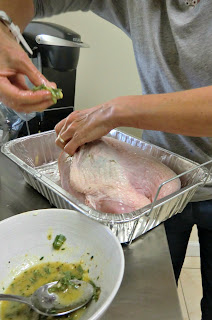European cooking Thanksgiving turkey in U.S.
Last November we spent Thanksgiving with family in the U.S. I was asked to cook the turkey. I have never before done this and had only a vague idea how the Americans tackle this. So I felt a bit like Julia Child travelling to Paris to cook the classic French dishes, only the other way round; now it was me travelling to the U.S. to cook their most classic dish.
In this internet age, I did a bit of googling about Thanksgiving turkey. It soon became apparent that even Americans can be apprehensive of the task. Thanksgiving is often a big party involving cooking in huge amounts and at the level of the traditional pilgrim cuisine. As ours was only a small family party of four, this at once lessened the stress level.
The first thing to decide was how much one should cook for four persons. The whole turkey was out of the question, but should one cook one turkey breast or two breasts, and what do the Americans mean by a “double turkey breast”? To understand this better, I had to calculate the American pounds into kilograms. As most internet sites that I saw recommended a “double turkey breast” for four persons because the tradition is also to have enough leftovers the next day, I settled for this. A “double turkey breast” weighs about 5- 7 lbs. / about 2, 3-3, 2 kilograms, although opinions about the weight varied hugely on the net.
The next thing was to find an appealing recipe on the net. After reading several recipes I finally chose Ina Garten’s because it had fresh herbs, lemon juice, garlic, black pepper, olive oil and white wine; a typical Italian combination of ingredients. For this recipe one needed a “double turkey breast” with skin, and I suppose that it always comes with a bone in the middle, or maybe not? After further googling it became evident that this is not a common thing to find in American
supermarkets because they mostly want to sell whole turkeys.
Because we would arrive only a few days before Thanksgiving, our family in the U.S. would order our “double turkey breast” as most websites recommended. So a few days before Thanksgiving we went to the local specialty supermarket to collect our “double turkey breast”. After some hassle in the shop our order finally arrived from the back room. To me the package seemed suspiciously large but I didn’t think too much about it. So it went straight into
our fridge.
When the package was opened on Thanksgiving it became clear that they had given us the whole turkey minus legs and wings! It was a moment when I missed the skillful French butchers, but at the same time felt that the situation must be dealt with true pilgrim spirit.
We started removing the “double turkey breast” from the rest of the body. After a lot of effort and my husband using all his surgical skills the “double turkey breast” finally sat in its oven
dish. Now I could continue placing the herb mixture under the skin.
Garten recommended to roast the double breast in 325 degrees F for only 1 ¾ - 2 hours which to me seemed a bit short. Other recipes recommended to roast 2 ¼ - 3 ¼ hours in 325 degrees to reach an internal temperature of 170 degrees F. I felt very American using an instant-read thermometer, I never do this in France and I don’t think they are very reliable. After more than three hours the temperature never reached 170 degrees so the turkey was taken out of oven and tested. It then rested covered for a while before being sliced.
The turkey was served with sweet potato mash, fried mushrooms, microwaved Brussels sprouts and sweet cranberry compote. The compote was cooked in a few minutes from fresh cranberries, orange juice and a little sugar and water.
The turkey was declared a great success, and we had plenty of leftovers for next day’s picnic sandwiches and a simple dinner of vegetable and turkey gratin.



















0 comments:
Note: only a member of this blog may post a comment.